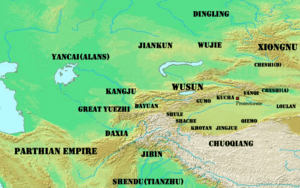Battle of Zhizhi facts for kids
Quick facts for kids Battle of Zhizhi |
|||||||
|---|---|---|---|---|---|---|---|
| Part of the Han–Xiongnu War | |||||||
|
|||||||
| Belligerents | |||||||
| Xiongnu Kangju allies |
Han Dynasty Wusun Tarim Basin city-states |
||||||
| Commanders and leaders | |||||||
| Zhizhi Chanyu † | Gan Yanshou | ||||||
| Strength | |||||||
| 3,000 Xiongnu cavalry and infantry with 10,000 cavalry reinforcement from Kangju | 40,000 | ||||||
| Casualties and losses | |||||||
| Heavy losses, with 1,518 killed, over 1,000 surrendered and 145 captured | Minimal or not reported | ||||||
The Battle of Zhizhi was an important fight in 36 BC. It happened between the powerful Han Dynasty of China and a leader of the Xiongnu people named Zhizhi Chanyu. In this battle, Zhizhi was defeated and killed.
This battle likely took place near a city called Taraz in what is now Kazakhstan. This makes it one of the farthest west a Chinese army ever traveled for a battle. Another famous battle, the Battle of Talas, happened in the same area much later, in 751 AD.
Contents
Why Did the Battle Happen?
In 56 BC, Zhizhi Chanyu had a disagreement with his brother. As his brother became stronger, Zhizhi moved west. Around 44 BC, he formed a close friendship with the Kangju people, who lived near Lake Balkhash.
However, Zhizhi later argued with the Kangju. He even killed some of them. He then forced the Kangju to build him a strong fort. This fort took 500 men two years to build. It was probably located near the city of Taraz.
The Battle Begins
How the Han Army Got Ready
Around 36 BC, the governor of the Western Regions (an area controlled by the Han Dynasty) was Gan Yanshou. His assistant, Chen Tang, believed that Zhizhi was planning to build a huge empire. Chen Tang suggested they attack Zhizhi first, before he became too strong.
Gan Yanshou didn't agree at first. But he soon became sick. While he was ill, Chen Tang pretended to be Gan Yanshou and ordered the army to get ready. Gan Yanshou had no choice but to agree. All of this was done without the Emperor's permission!
A large army of 40,000 soldiers was gathered. This army included both Han Chinese troops and 'Hu' troops (a general name for non-Chinese people). They marched west, traveling on both sides of the Tarim Basin. They met up again near Kashgar and then moved through Kangju land.
Fighting at Zhizhi's Fort
The Chinese army arrived about 30 li (about 15 kilometers) from Zhizhi's fort. The two sides exchanged messages, but they weren't very honest with each other. The Chinese then moved closer, to within three li (about 1.5 kilometers) of the fort, and built their own defenses.
The Xiongnu sent out hundreds of horsemen and foot soldiers. But the Chinese pushed them back into the fort. The Chinese followed and attacked the fort, even managing to burn part of its wall. That night, several hundred Xiongnu horsemen tried to escape, but they were all killed. Zhizhi himself thought about escaping but decided to stay. He knew he had too many enemies in the surrounding lands.
The fighting continued. Zhizhi's queen and other important women even shot arrows from the fort's walls. Zhizhi was wounded in the nose by an arrow.
Soon after midnight, the outer walls of the fort were broken through. The Xiongnu soldiers retreated to the inner part of the fort, called the citadel. At this point, thousands of Kangju horsemen appeared and attacked the Chinese in the dark. But they couldn't do much damage.
When morning came, parts of the inner citadel were on fire. The Chinese piled dirt against the walls and climbed into the citadel. Zhizhi and about a hundred warriors retreated into the palace inside the fort. The palace was set on fire and attacked from all sides. Zhizhi was badly wounded and died.
What Happened After the Battle?
A total of 1,518 Xiongnu people died in the battle, including Zhizhi and his wives. 145 Xiongnu were captured, and over 1,000 surrendered. The Han soldiers were allowed to keep the treasures they found. The Xiongnu who surrendered were given to the fifteen kingdoms that had helped the Han in the battle.
Zhizhi was the only Xiongnu leader (called a Chanyu) ever killed by the Chinese. This battle was a big victory for the Han Dynasty.
Images for kids



